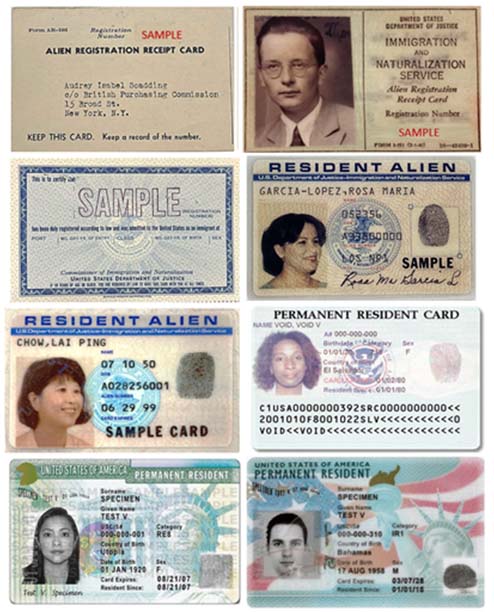The Colorful History of the Green Card
In January 2023, USCIS released a redesigned Permanent Resident Card or “Green Card.” This design contains state-of-the-art technology, including holographic images and optically variable ink. Visually, this Green Card retains much of the previous version’s design (PDF, 1.69 MB), which also featured a red, white, and blue flag on a green background.

Registration Receipt Form Card (1940); Form I-151 (1946), the original Green Card;
Form I-151 (1964); Form I-551 (1977), the new machine-readable Green Card;
Form I-551 (1989), the first Green Card with an expiration date; Form I-551 (1997);
Form I-551 (2010), which brought back green coloration; Form I-551 (2017).
While this version of the card features a green background, previous versions of the Green Card have been blue, tan, and even pink. Which leads to the inevitable question: Why does USCIS call it a Green Card? The answer can be found in the story of the Green Card’s early years.
The concept of a card to prove a person may live and work permanently in the United States began with the Alien Registration Receipt Card. The first receipt cards were printed on Form AR-3 on white paper and were the result of the Alien Registration Act of 1940. Passed in response to the start of WWII, the Act required all non-citizens in the U.S. to register with the federal government. Noncitizens registered at post offices and the registration forms were sent to the Immigration and Naturalization Service (INS) for processing. After processing, INS mailed a Form AR-3 receipt card to each registered noncitizen to serve as proof of registration. The Alien Registration Act did not make distinctions between lawful permanent residents (LPRs) and other noncitizens. All noncitizens registered and all received the same receipt card.
After World War II ended, registration became part of regular immigration procedure. Rather than registering at the post office, new arrivals registered upon arrival at a port of entry. Under the new procedure, INS issued different registration documents to noncitizens based upon their admission status. For example, visitors received an I-94c and temporary workers received an I-100a. Lawful permanent residents received a Form I-151, printed on green paper. The small, green I-151’s value quickly became apparent to immigrants. As early as 1947, new LPRs began complaining about delayed I-151 processing because employers would not hire them until they could prove their LPR status – something the I-151 cards allowed them to do with little effort.
After the Internal Security Act passed in 1951, new INS regulations solidified the I-151 receipt card’s importance for proving LPR status. As mentioned above, INS issued the original AR-3 Alien Registration cards to all noncitizens in the U.S., whether they were LPRs or not. Under the new regulations, AR-3 holders who could prove their lawful admission to the U.S. could replace their AR-3 with an I-151 or Green Card. Those who could not show their lawful admission did not qualify for LPR status. They could not receive the I-151 card and might even be subject to prosecution for violation of U.S. immigration laws.
As a result, the green Alien Registration Receipt Card Form I-151 represented security to its holders. It indicated the holder’s right to live and work in the U.S. and communicated those rights to law enforcement offices. The card’s unwieldy official name also invited abbreviation. Soon immigrants, their attorneys, and even INS employees began referring to the card by its color. In short order, the phrase “Green Card” came to represent the card itself and the LPR status it communicated.
Because many noncitizens who were in the U.S. on a temporary status or here without documentation sought Green Card status, counterfeit I-151’s soon became a serious problem for INS. To combat fraud, INS issued 19 different designs of the form between its introduction in the 1940s and its complete revision in 1977. In 1964, the card’s color changed to pale blue. The next year it became dark blue. By then however, the term “Green Card” carried a meaning deeper than the color of the paper it was printed on. Despite the changing color, Americans and immigrants continued to refer the I-151 as the Green Card and to refer to LPRs as “Green Card holders.”
In 1977, INS retired the I-151 and replaced it with a new machine-readable Alien Registration Receipt Card. The new card was more durable and it included enhanced security features. It was given form number I-551, the number USCIS still uses for the Permanent Resident Card. Over the years, INS produced I-551 cards in various colors, including pink and pink-and-blue.
In 2010, USCIS introduced green back into the card’s primary color scheme. Today, the card includes red, white, and blue, as well as a nod the card’s green origin. However, because of the card’s color when it became important in American immigrants’ lives, despite changes in color and design, the document which represents an immigrant’s right to live and work in the U.S. will likely always be known as a “Green Card.”
